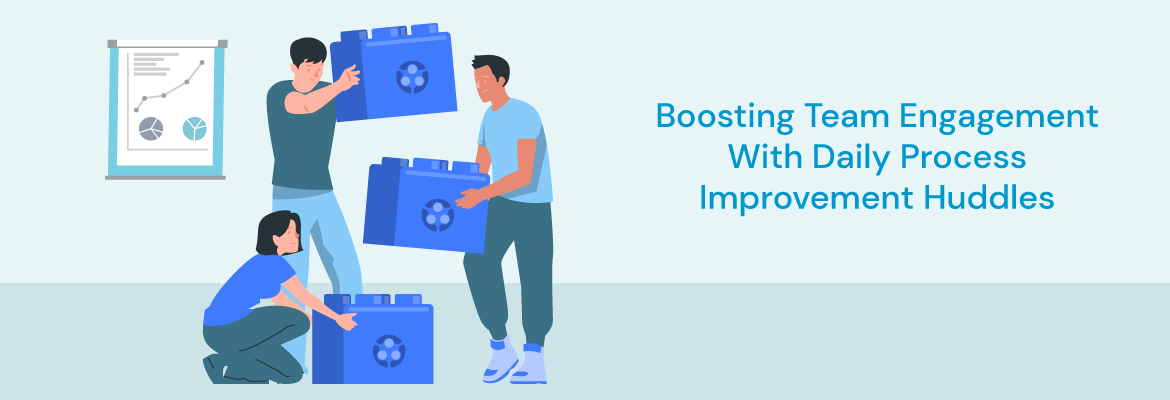
Boosting Team Engagement With Daily Process Improvement Huddles
Introduction
In today’s fast-paced business environment, organizations strive to achieve continuous improvement to stay ahead of the competition. One effective way to drive improvement is through daily process improvement huddles, where frontline staff come together to track and discuss leading metrics, identify root causes, and implement actionable ideas. This article explores the power of daily process improvement huddles in breaking down bigger problems into manageable tasks, promoting team engagement, and fostering a culture of continuous improvement.
The Importance Of Leading Metrics
To effectively improve a process, it is essential to identify leading metrics that provide insights into its performance. Frontline leaders must be aware of the overall state of the organization’s scorecard. While celebrating when everything is green is important, it is equally crucial to understand which specific actions or processes contribute to success.
Without breaking down key performance indicators (KPIs) into manageable daily or weekly actions, it becomes challenging to make improvements. Daily or weekly tracking helps break down the problem into task-level details and enables the identification of root causes, leading to effective solutions.
Connecting Ideas To Leading Metrics
Ideas alone are not enough for successful improvement. It is essential to connect ideas to specific leading metrics to determine their impact. By tying ideas to metrics, organizations can track the outcomes and make informed decisions about their effectiveness. This clarity allows frontline staff to feel empowered and in control of their work and outcomes.
For instance, let’s consider a team aiming to enhance sales performance. Simply discussing general ideas without connecting them to a leading metric may not yield concrete results. However, by aligning the ideas with a specific leading metric like the number of qualified leads generated per week, the team gains a clear target. Tracking this metric allows them to assess the impact of their ideas on lead generation and make necessary adjustments to improve sales performance.
In another example, let’s focus on a process aimed at reducing customer support response time. Instead of discussing vague ideas, connecting the ideas to a leading metric such as average response time per ticket provides a tangible focus. By tracking this metric, the team can monitor the effectiveness of their improvement ideas, identify bottlenecks, and implement strategies to optimize response time.
By connecting ideas to relevant leading metrics, organizations empower their teams to take meaningful actions. It ensures that improvement efforts are grounded in measurable results, fostering a culture of continuous improvement and enabling teams to drive positive change based on real-time data.
Implementing Daily Process Improvement Huddles
To leverage the power of daily process improvement huddles, organizations should follow a structured approach:
- Select a Metric: Identify a leading metric that requires improvement. This becomes the focus area for the huddle.
- Identify Leading Metrics: List all the incoming and outgoing processes related to the leading metric. These are the leading metrics that influence the main metric.
- Daily Huddle Engagement: Engage the team in daily huddles and select one or two leading metrics to track and discuss. Since the team is directly involved in these processes, they can easily engage in meaningful conversations and contribute improvement ideas.
- Tracking and Root Cause Analysis: Encourage manual tracking of leading metrics if data is not readily available. This helps determine if the selected processes are problematic. In daily huddles, focus on reviewing the collected data and engage the staff in identifying root causes.
- Implementing Ideas: Prioritize low or no-cost improvement ideas that can be quickly implemented without extensive permissions or involvement from other teams. Seeing their ideas in action energizes the staff and highlights their value in the improvement process.
FAQs
How frequently should daily process improvement huddles be conducted?
Daily huddles are typically held on a daily basis, allowing for regular monitoring and quick decision-making.
What if the leading metrics do not show significant improvement?
If the selected leading metrics do not yield substantial improvement, organizations can pick the next metric from the list and repeat the process.
How can organizations ensure sustained engagement in daily process improvement huddles?
Regularly communicate the importance of daily huddles, highlight success stories resulting from previous huddles, and recognize the contributions of staff members to maintain engagement.
Conclusion
Daily process improvement huddles provide organizations with a powerful tool to break down larger problems into manageable tasks, drive team engagement, and foster a culture of continuous improvement. By connecting improvement ideas to specific leading metrics and involving frontline staff in meaningful conversations, organizations can empower their teams to take ownership of the improvement process. Through daily tracking, analysis of root causes, and implementation of actionable ideas, organizations can achieve sustained improvement and drive success in today’s competitive business landscape.



 December 9, 2023
December 9, 2023